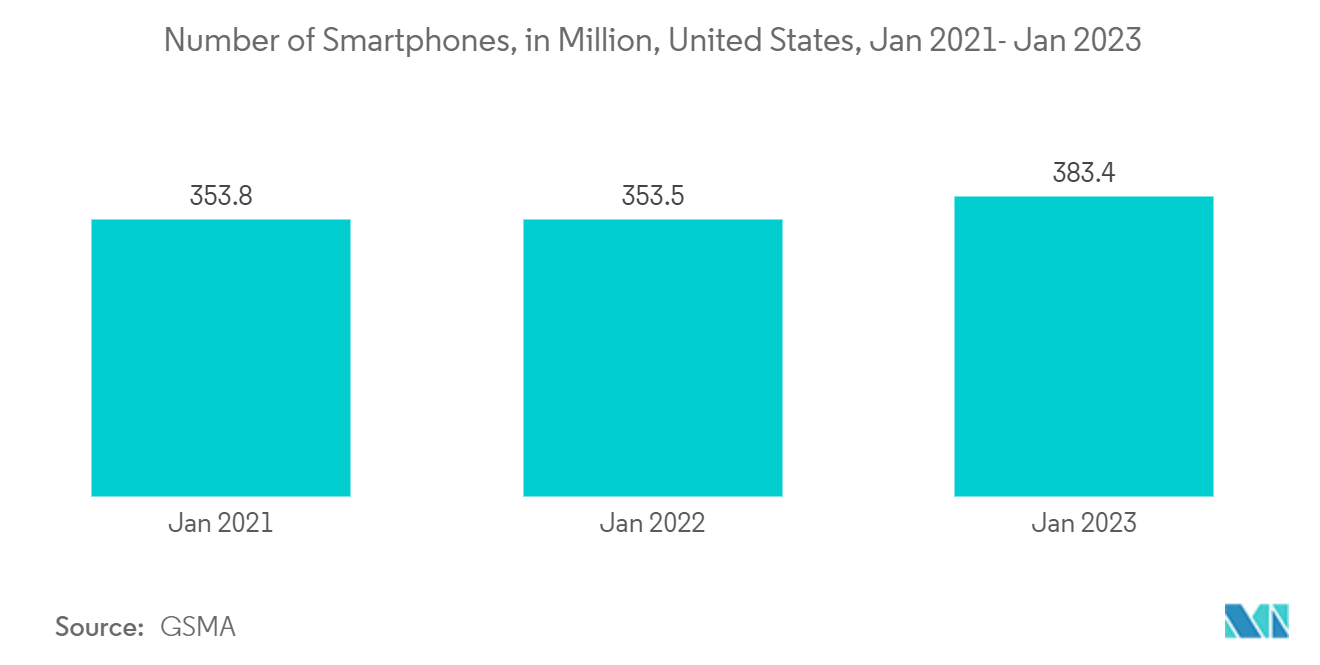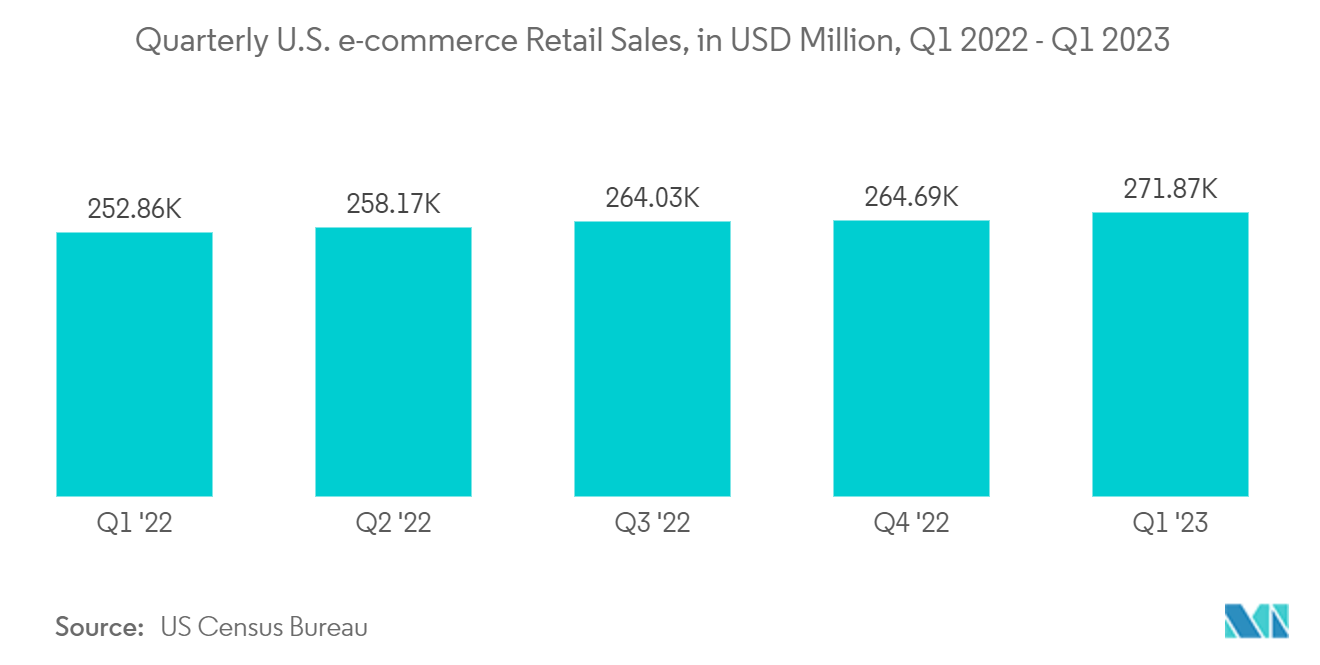Market Trends of US Location-based Services Industry
Indoor Location Segment is Expected to Hold Significant Share of the Market
- Indoor location-based services (LBS) are gradually gaining traction due to the increasing penetration of smartphones, the development of sensor technology, and the increase in indoor time. Sensor technology has enabled smart networks to receive data from a smartphone without installing additional devices, making smartphones the most commonly used data source for indoor positioning.
- In several cases, installation and integration services are of high prominence in the market owing to increased customized and indoor LBS solutions. Installation of hardware and integration of custom technologies into locally deployed applications, etc., are some of the professional services that are growing at a faster pace in the market.
- These sensors or hot spots are called bluetooth low energy (BLE) beacons, which are used to locate devices and users inside a building. Other kinds of indoor positioning being used by organizations are Wi-Fi and Geomagnetic. Thus, IT managers, marketing managers, facilities personnel, and other stakeholders are responsible for purchasing, installing, and maintaining these systems. Indoor tracking applications are beneficial in Indoor Location Tracking/Positioning, Proximity Marketing, and Real-time Wayfinding for large facilities, such as airports, hospitals, stadiums, and convention centers.
- There is active research on designing and implementing an indoor positioning platform to subsidize the development of future location-based 5G network functionalities and services. However, the built-in smartphone sensors' readings are easily affected by the surrounding environment and are occasionally different, adversely influencing indoor positioning accuracy. For instance, the built-in gyroscope sensor and the magnetometer sensor can be used to measure a user's heading direction, which may be different from each other and occasionally from themselves. As a result, this error accumulates, and the user's position may become increasingly inaccurate.
- The location-based services, combined with real-time location systems, offer features like real-time object tracking, process tracking, and personnel tracking and help manufacturers manage their resources. With large manufacturer concentrations in the country, the demand for these solutions is high. The increased use of LBS in healthcare is also a driving factor for the market's growth. The healthcare industry in the United States is booming and is adopting automation and IoT technologies quickly. These services in the healthcare sector offer a very reliable and effective solution, along with patient tracking, process tracking, and other features. With increasing demand for high-quality healthcare, the industry has witnessed an increasing demand for these services.
- According to GSMA, 383.4 million cellular mobile connections were in the United States at the start of 2023. Such a huge number of mobile penetration would create an opportunity for indoor location-based services firms to develop new services to expand their market share. With the help of indoor mapping and navigation products, patients can be assisted in making their way to and through any healthcare facility. Real-time information can be conveyed to the patients depending on where they are in the hospital, allowing them to make appointments on time and find the correct testing area.

FMCG and E-Commerce Sector Anticipated to Witness Substantial Growth
- Mobile applications assist e-commerce stores in analyzing the current market and consumer behavior, resulting in better marketing strategies. Modern information services now include a particularly significant portion of e-commerce services depending on user location. Quality of service is crucial in these user-intensive systems, and design methodologies increasingly rely on software standards to accomplish quality. Beyond food and restaurants, all nations are witnessing a trend of location-based food delivery services. Due to the introduction of GPS and mapping, LBS has proved to be of the utmost advantage for food delivery platforms.
- Moreover, customers get customized offers from e-commerce applications in the country. Customers are given access to these deals through personalized push notifications, which are more efficient than general-purpose push notifications. In other words, artificial intelligence is used by marketplaces to determine which areas and products are in demand there. Sellers can pay a one-time fee when the data is set up to have their products delivered to the destination.
- Growth in the market is being driven by the expansion of the e-commerce sector and the demand for effective location-based services throughout the country. For instance, the US Census Bureau announced that the estimate of US retail e-commerce sales for the first quarter of 2023, adjusted for seasonal variation but not for price changes, was USD 272.6 billion, an increase of 3.0 percent (±0.7%) from the fourth quarter of 2022.
- The Uber Eats online food delivery app is a prime example of applying location-based services to provide more user-friendly experiences. This app uses two-way location-based technology to target the user's location, and the user can see a live view of the driver's location on a map. The company also plans to enlist autonomous vehicles to cart some orders in Los Angeles starting early next year. Uber is collaborating with Serve Robotics to make it happen. Robot delivery will be allocated to Uber Eats customers based on availability and location. The firms are still working out the details of the fees associated with each order.
- Apart from Geofencing, food delivery companies can fetch insights from a customer to know the kinds of cuisines they like, cuisine gaps, restaurants from which food is generally ordered, and the distance of the restaurant from the delivery person. To retain customers, restaurants are opting for online food ordering app development. Munchery is a US-based full-service delivery model where customers can order food by looking at the dish's image, list of ingredients, and the name of the chef who will prepare it. It has its own logistics facilities that use Google Maps to locate the customer's position.


